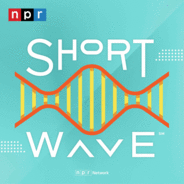Lightning: It happens all the time, and yet the exact details of how it's made has long eluded scientists. That is, until now. New research out this week in the journal Nature holds new insights into the precursor to lightning. To figure it out, researchers flew a NASA ER-2 – essentially the research version of a spy plane – over several tropical thunderstorms. What they found: The same high energy radiation is found in places like neutron stars and around black holes. Want to hear more stories about the science behind natural phenomena? Email us at shortwave@npr.org — we'd love to hear from you!Learn more about sponsor message choices: podcastchoices.com/adchoicesNPR Privacy Policy

Wissenschaft & Technik
Short Wave Folgen
New discoveries, everyday mysteries, and the science behind the headlines — in just under 15 minutes. It's science for everyone, using a lot of creativity and a little humor. Join hosts Emily Kwong and Regina Barber for science on a different wavelength.If you're hooked, try Short Wave Plus. Your subscription supports the show and unlocks a sponsor-free feed. Learn more at plus.npr.org/shortwave
Folgen von Short Wave
1406 Folgen
-
Folge vom 04.10.2024What Lightning And Black Holes Have In Common
-
Folge vom 02.10.2024Why Astronomers Are Teaching Climate ChangeYears ago, astronomy professors started noticing something that troubled them: Many of their students didn't understand climate change and the science supporting it. So a small group of professors decided to do something about it — teach climate change in their introductory astronomy courses. Want to hear more stories about climate change? Email us at shortwave@npr.org — we'd love to hear from you!Learn more about sponsor message choices: podcastchoices.com/adchoicesNPR Privacy Policy
-
Folge vom 01.10.2024If Fungi Win, Will We Be Ready?Over six million fungal species are believed to inhabit planet Earth. Outsmarting them is the work of Arturo Casadevall's lifetime. What If Fungi Win? is the question at the heart of Arturo's new book, co-authored with journalist Stephanie Desmon. In this episode, Emily and Regina take a trip to Arturo's lab at Johns Hopkins University in Baltimore and meet a group of scientists thinking about the fungal consequences of climate change, urban heat islands, and scooping up microbes with candy. Curious about fungi? Email us at shortwave@npr.org — we'd love to hear from you!Learn more about sponsor message choices: podcastchoices.com/adchoicesNPR Privacy Policy
-
Folge vom 30.09.2024Do NYC Birds Hold The Clues To The Next Pandemic?Most viruses that become epidemics in humans begin in other animals. It's how scientists suspect COVID-19 emerged. And now, less than five years after the start of the pandemic, some scientists are concerned about another disease that could do something similar: bird flu, or H5N1. Over the past year, the virus has spilled into cows and other animals — even infecting some people working closely with the animals. Some scientists hope to build a more resilient public health system by finding ways to detect and to track viruses as they spread in animals. One team in New York City is doing this by tapping high school students from underrepresented backgrounds. Together, they create a more equitable field of biologists while they also sniff out what could be the next pandemic.This story was produced with support from the Education Writers Association Reporting Fellowship program. Want to know more about pandemic surveillance or virology? Email us at shortwave@npr.org — we might cover it on a future episode! Learn more about sponsor message choices: podcastchoices.com/adchoicesNPR Privacy Policy
